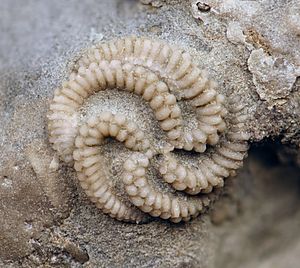Edrioasteroidea
| Edrioasteroidea | ||||||||||
|---|---|---|---|---|---|---|---|---|---|---|

Streptaster vorticellatus from the Upper Ordovician of northern Kentucky . |
||||||||||
| Temporal occurrence | ||||||||||
| Cambrian to Middle Permian | ||||||||||
| 516 to 272.5 million years | ||||||||||
| Locations | ||||||||||
| Systematics | ||||||||||
|
||||||||||
| Scientific name | ||||||||||
| Edrioasteroidea | ||||||||||
| Billings , 1858 |
The Edrioasteroidea are an extinct class of echinoderms . They are among the oldest echinoderms, have been recorded in fossil records since the Lower Cambrian and died out in the Middle Permian . Their diversity remained low, the Ordovician seems to be the peak of their diversity with over 20 genera.
features
The Edrioasteroidea were marine, sessile, but not firmly grown organisms, which could probably suck up to the substrate with their underside, similar to sea anemones . Their capsule-like body (theka) was disc-shaped, sack-shaped or tower-shaped or had the shape of a hemisphere. The diameter was usually 15 to 30 mm, the minimum 5 to 7 mm, the maximum 90 mm. In the middle of the theka was the mouth, covered by small plates, from which five ambulacral fields emanated, most of which curved counterclockwise. The ambulacral fields are supported by one to two-line floor slabs. They are provided with pores, which can also be closed secondarily. Larger cover plates are located on the outer edges of the ambulacral fields, to which smaller cover plates are attached to the center line of the ambulacral fields. They protected the ambulacral feet while the animal was resting.
Way of life
The Edrioasteroidea lived in shallow water, probably nourished themselves as suspension eaters, filtered planktonic organisms from the flowing water with their ambulacral feet and carried them to their mouths through ciliate slime channels.
literature
- Bernhard Ziegler: Introduction to Paleobiology, Part 3, Special Paleontology, Worms, Arthropods, Lophophorates, Echinoderms . Stuttgart: Schweizerbartsche Verlagbuchhandlung, 1998, ISBN 3-510-65179-0
Individual evidence
- ^ E. Billings: On the Asteriadae of the Lower Silurian Rocks of Canada . In: Geological Survey of Canada, Figures and Descriptions of Canadian Organic Remains , Decade III, pp. 75–85, 1858. (digitized version)
- ↑ Colin D. Sumrall: First definite record of Permian Edrioasteroids: Neoisorophusella maslennikovi n. Sp. from the Kungurian of Northeast Russia. Journal of Paleontology, 83 (6): 990-993, 2009 doi : 10.1666 / 09-063.1 (digitized version )
Web links
- The Paleobiology Database: Edrioasteroidea